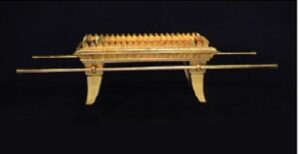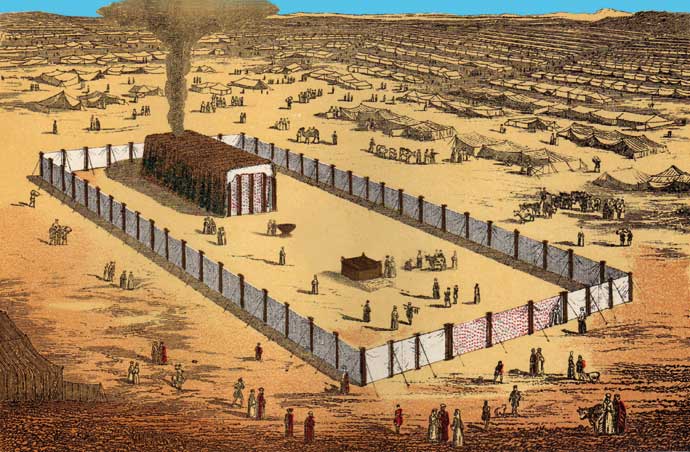 Last week we studied the construction of the table of Shewbread (Showbread) first mentioned in Exodus 25:23-30. In Leviticus 24:6, this same table is referred to as the Pure Gold Table. Some translations refer to it as the Table for the Bread of the Presence. The term showbread comes from a Hebrew word that means the bread of the face or bread of the presence. And that’s where we will begin this study – what was the purpose of this table?
Last week we studied the construction of the table of Shewbread (Showbread) first mentioned in Exodus 25:23-30. In Leviticus 24:6, this same table is referred to as the Pure Gold Table. Some translations refer to it as the Table for the Bread of the Presence. The term showbread comes from a Hebrew word that means the bread of the face or bread of the presence. And that’s where we will begin this study – what was the purpose of this table?
If you Google “Table of Showbread” you will see a variety of representations of the bread on this table. Some appear to look like freshly baked loaves out of your aunt’s oven, while other images show something like thick pancakes stacked – or perhaps two piles of pita bread for a total of 12 loaves – six per pile. The reality is – we are mostly guessing at the exact look of something that commenced 3500 years ago.
After reading about how the table was to be constructed, we read these words:
You shall set the bread of the Presence on the table before Me at all times. Exodus 25:30 NASB

And then, we get many more details about the bread in Leviticus 24:5-9:
“Then you shall take fine (pure) flour and bake twelve cakes with it; two-tenths of an ephah shall be in each cake. (6) “You shall set them in two rows, six to a row, on the pure gold table before the LORD. (7) “You shall put pure frankincense on each row that it may be a memorial portion for the bread, even an offering by fire to the LORD. (8) “Every Sabbath day he shall set it in order before the LORD continually; it is an everlasting covenant for the sons of Israel. (9) “It shall be for Aaron and his sons, and they shall eat it in a holy place; for it is most holy to him from the LORD’S offerings by fire, his portion forever.” Leviticus 24:5-9 NASB
There is so much that could be said about the Table and the Bread in these two lessons and so many truths that we could draw out about our fellowship with the Lord and with one another. You could trace the motif of bread throughout the four Gospels. We could also think about 1 Corinthians 11:23 about Jesus in the Upper Room taking the bread on the night of His betrayal and instituting the Lord’s Supper. But you can go deeper in your study of this subject on your own.
Someone has calculated the actual amount of flour used for the twelve loaves of bread – six pounds of flour. As for this bread set before the Lord on the pure gold-covered table – did it contain any yeast? Were the loaves ‘raised’ from the action of yeast and then baked? The Bible doesn’t explicitly state that the bread was ‘unleavened,’ but because it was to be a ‘meal offering’ to be used in the Tabernacle, we can safely conclude it contained no yeast additive.
The process did not produce that fineness in His holy character, it proved it.
Who got to eat this bread? Representatives from each of the twelve tribes of Israel? No – the bread was to be appreciated by the Lord and eaten inside by only the priests who worked and ministered inside. The two piles of six on the table (totalling twelve) remind us that there was sufficient for all of Israel. Even though the entire nation did not get to eat the showbread, those who represented them did have the privilege. There is no scarcity in Christ – sufficient for all to enjoy.

Don’t confuse this bread with the manna-bread. All the children of Israel, as they travelled through the wilderness, got to enjoy the manna-bread, which is a type of Christ. They were pilgrims, and the manna was their daily food in the wilderness – just as Christ is our daily food as we live our lives on Planet Earth. But the showbread takes us to another dimension. It was the food of the Levitical priests as they worked inside in the sanctuary.
“The showbread is a picture to us of our Lord Jesus Christ as the Bread of God. As believers in this dispensation, we are both pilgrims and priests. We need Christ for both the wilderness and for our Sanctuary service.” (1)
Did you notice that the bread was to be made out of pure or fine flour? How might that speak to our hearts about our Lord Jesus Christ? Did He have any coarseness, impurities or irregularities? No! Fine and pure flour, indeed! Study His sinless and holy life as you read the four Gospels. Admire His beautiful consistency and evenness. Everything about Him was in perfect balance. One aspect of His personality did not overshadow, outweigh or compromise another. John wrote:
And the Word became flesh, and dwelt among us, and we saw His glory, glory as of the only begotten from the Father, full of grace and truth. John 1:14 NASB
Fine flour! For us to bake with fine flour – it is the outcome of a process. The kernels of grain must be crushed, ground and sifted to achieve the fine powdery flour. Yes, Jesus experienced the brutal process of the crushing and sifting but is that what made Him perfect? Absolutely not. Never push or press an example or an analogy too far, point by point. Understand the limitations of a type or a picture, or an analogy.
Jesus endured the sifting process of being tempted by Satan, and He went through the difficult process of being ‘tested’ by the religious leaders. Many other aspects of His 33 years of life here could be compared to the beating and grinding, and sifting process that produced the fine flour. And each time, He proved He already was perfect and without sin. The process did not produce that fineness in His holy character, it proved it.
“Just as the flour had to know the heat of the oven before it could be placed on the table, Christ knew the trials and afflictions of being a holy Man in an unholy world.” (2)
Think of the fragrance of the frankincense that was also included in the bread display. As much as we appreciate Christ, think of the fragrance of His holy life that ascended to God every day. What a contrast to the stench rising from this planet! It’s highly probable that the priestly men would have picked up and carried and emitted its scent and fragrance after enjoying the showbread each Sabbath. As a believer-priest – how could this little thought relate to you?
Sources:
- A.J. Higgins, Monday Meditations
- ibid.


In smooth and silken whiteness,
Without a roughening grain
In clear, unbroken brightness
Without a speck or stain
The fine flour in its beauty
The perfect man portrays
In all His path of duty
In all His heavenly ways ?
– I.Y Ewan
I praise our YAHWEH GOD through our beloved Lord & Saviour YAHSHUA MESSIYAH for this wonderful explanation given regarding The Bread on The Table. may GOD bless you.